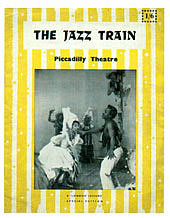The Jazz Train

A Musical Revue "Dedicated to the Negro People"
Conceived by Mervyn Nelson. Music and Lyrics by J.C. Johnson. Choreography by Herbert Harper. Scenery & Costumes by Loudon Sainthill. Orchestrations by Peter Knight
Piccadilly Theatre, London - 26 April, 1955 (111 perfs)
Synopsis
The Jazz Train was 'A Musical Dedicated To The Negro People', but was not a conventional book musical. The 'train' was made up of 'cars' (coaches), each one representing a different period or stage in the evolution of black American popular music as seen through the eyes of Mervyn Nelson, the director and devisor of the show.
The railroad journey started with a prologue, I Got A Train, sung by Jeff Williams, the engineer (driver) of the powerful engine, before it started to roll in the 'Congo Car' with a happy vibrant ritual dance which at once reminded the audience of the African roots of American black people. The horrors of slavery, and importance of religion to early slaves, were dealt with in the 'Spiritual' and 'Plantation' cars, but the show quickly developed into a celebration of success through 'Minstrel', 'Blues', 'Show' and 'Calypso' cars.
The Jazz Train, strangely billed as 'The Broadway
Smash Hit' despite the fact that it had only been seen in a New
York night-club, was a moderate success, running for 111 performances
after its April 26, 1955 opening night at the Piccadilly Theatre.
At first sight it was simply a continuation of the Blackbirds
tradition of Afro-American revue, but in the three decades that
separated the shows important social and political events had
occurred giving pride to the black people of America. The cast
impersonated many great black performers: impressions of Paul
Robeson, Florence Mills, Louis Armstrong, Ethel Waters and Bessie
Smith were featured in a section called 'Stars', and in the 'Show
Car' there were excerpts from Porgy and Bess, Carmen Jones and
the original Blackbirds.
The show introduced the great Bertice Reading to English audiences singing the tale of Frankie and Johnny and impersonating Bessie Smith; Lucille Mapp was another name which would soon become familiar to London theatregoers. Of the men, Edric Connor stood out as the preacher in the Holy Roller Car, and as the whiskered Mr. Interlocutor in the Minstrel Car. Isabelle Lucas, at this point in her career still in the chorus, would develop into a respected performer.
Energy and excitement abounded in The Jazz Train and it was not a show for those wanting a quiet night out. This was a rather long train, kept moving largely through the medium of African and American dance. The entire cast frequently appeared on stage at the same time, and at one point even spilled into the auditorium. The show moved easily from spiritual to rowdy night club scene and the finalé was the confident 'No Journey's End To My Train' performed by the cast packed into a railway car that took over the stage.
However, for all its colour and verve the show remained episodic, picking its specimens of black achievement at will; and this made the production more akin to an elaborate cabaret than a revue.
Taken from the liner notes to the Sepia Records reissue of the Parlophone recordings. (SEPIA 1062)
Musical Numbers include
- Prologue - I Got A Train
- Sprituall Car
- Plantation Car
- Holy Roller Car
- Minstrel Car
- Frankie and Johnny
- Bessie Smith Blues
- Ev'rything Is Rhythm
- Calypso - (Manman la grève barre)
- Basin Street Lover
- John Henry
- Finale (There's No Journey's End To My Train
Original Cast
- Roy Carr
- Edric Connor
- Lucy Guannel
- Boscoe Holder
- Fredye Marshall
- Bertice Reading
- Tony Scott
- Jeff Williams